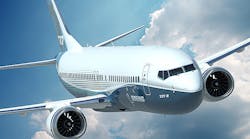Boeing Commercial Airplanes has issued a new 20-year outlook for demand by airlines serving Latin American markets, projecting the region will require three times as many jets to fulfill air traffic requirements. Specifically, the OEM sees the regional demand requiring 3,050 new airplanes by 2035, and projects that as a $350-billion market.
The forecast for new aircraft is slightly higher than the 20-year regional outlook Boeing issued last November, though the capital-investment projection has not changes.
Boeing noted that Latin America and the Caribbean market currently is served by a younger-than-average, and that fleet’s average age will continue to decline, from more than 15 years in 2005 to less than 10 years today.
It further noted that the region has been in a steady replacement cycle over the past 10 years, and that the trend will continue, as almost 60% of the current fleet will be replaced by 2035.
“Over the long term, Latin American economies will grow faster than the rest of the world,” explained Boeing Latin America president Donna Hrinak. “This growth will create increased passenger traffic in the region and drive Latin American airlines to expand and compete for business that has traditionally been dominated by foreign operators.”
In specific terms, Boeing forecast Latin American airlines will require more than 2,500 new single-aisle airplanes through the coming two decades, noting that finding maintains the current general trend in commercial aviation favoring low-cost carriers, as well as further expansion of Latin America’s current route system.
Wide-body aircraft demand is pegged at 340 new airplanes, the increase coming from Latin American’ regional carriers becoming more competitive with the larger global carriers on long-haul routes.
Boeing added that of all the two-aisle aircraft currently serving the Latin America market, more than two-thirds are Boeing models.
Currently, Latin American customers have 260 aircraft on order from Boeing.
In particular, it pointed out that Boeing’s 787 Dreamliner has gained some market presence in the region, with orders by LATAM (an airline based in Chile), Avianca (Colombia), and Aeromexico fleets, which has allowed those airlines to add new routes and expand market coverage: as an example, it noted that Aeromexico operates a nonstop route from Mexico City to Tokyo — which thanks to the 787 can be completed without a refueling stop.
Moreover, last year LATAM operated the first ETOPS (a flight protocol for extended operations, meaning a long-distance flight conducted by a two-engine jet) mission for a 787 beyond 180 minutes, from Santiago, Chile, to Auckland, New Zealand. Later this year, the airline will operate an ETOPS flight for the same route, running the full 330 minutes, and cutting 90 minutes off the flight time and up to 2,500 gallons of fuel for the trip.










